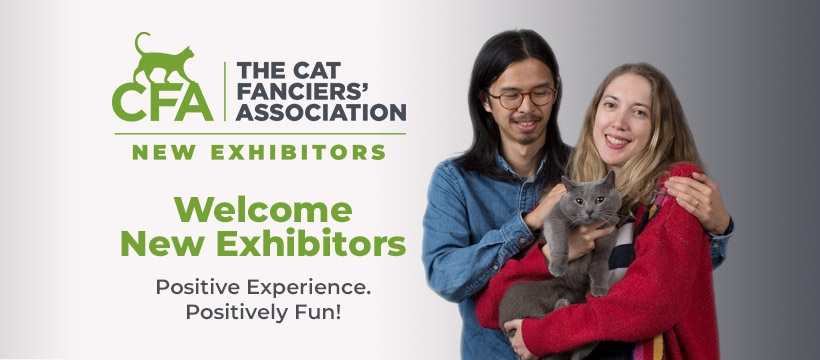Ann Segrest once posted on the CFA List a very clear-eyed and ‘to the point’ observation on non-productive attitudes and behaviors of new (and often experienced) exhibitors. The following text has been somewhat altered for syntax and used with Ann’s permission.
I, too, have observed that sometimes newbies don’t get the respect that they (and/or their very fine cat) might deserve. I’ve come up with a few reasons this might happen. This is not a comprehensive list. NOT ALL newbies are unsuccessful. NOT ALL oldies get all the finals.
So let’s just approach this with an open mind and you can all see if you see yourself in one or more of these scenarios. NOTE: I am using the word “newbie” to include new exhibitors, new breeders, wannabe either of those, and maybe some spectators. Remember that some newbies have been in the cat fancy for decades, but are still repeating that experience without learning anything new.
1. Asks a lot of questions, and ignores the answers. Then asks the same questions again, having not listened to the answers the first three (thirty, three hundred) times. This happens from the time the newbie thinks about getting a cat to the time the newbie either figures it out or leaves the cat fancy in a huff, trailing invectives all the way.
2. After 3 cat shows, whether the cat is successful or not, has become an EXPERT on either that breed or all breeds of cats. Becomes the unwelcome mentor (or cheerleader) of everyone in that benching area.


3. Draws attention to self and self’s cat in the judging ring: waving toy, discussing cat in carrying voice, making a production of putting cat into judging cage and taking it out. This, of course, is not limited to newbies.
4. Believes that criticizing the competition, particularly in breed, particularly in front row of judging ring, is not only OK, but will enhance the judge’s awareness and admiration of one’s entry.
5. Uses negative body language when one’s cat doesn’t get final, BOB, or Best CH. Directs that unhappiness at the cat all the way back to the benching area, which is observed by the judges, other exhibitors, and spectators.
6. Hangs around experienced, successful (and very busy) breeder-exhibitor in the mis-guided belief that if one stands next to glory, glory will come on down! Cannot figure out why this close association does not result in more finals.

7. Tries EVERY (and I mean EVERY) bathing formula and suggestion solicited and given — sometimes (often) in combination — and then cannot understand when cat’s coat is dry, oily, clumping, falling out, or full of static. Blame is assigned elsewhere for this problem. Oh, yes. Some of these bathing experiments happen for the first time on the night before the show.
8. Speaking of assigning blame….Blames everyone else when the cat or kitten is not behaving well at the show, having not show-trained the cat at all. Blames the judges for not picking their cat, having not handled the competition and knowing nothing about the physical condition, physical structure, or temperament of any of the competing cats.
I could go on, and I’m sure I missed a lot of ways that newbies shoot themselves in the foot rather than go to the effort to quietly learn about their cat, their cat’s breed, and the cat fancy.
It isn’t about paying dues. It isn’t about paying a lot of money for a cat with a particular cattery name on the front. It isn’t about knowing that your cat is a really good example. It isn’t about being seen with a certain group. It isn’t about impeccable grooming, if the underlying cat is not properly constructed.
Some of it is about etiquette, which is sometimes overlooked when we bring a new person into the fancy. I was so very lucky when I started. I had breed mentors (Dennis Ganoe and Judy Buckle-Ganoe), who taught me how to show my Korat. They introduced me to the other Korat breeders. They encouraged me and set a good example of show hall conduct. I learned how to campaign a cat that year, because the first kitten from my own breeding became a Breed Winner and I had to campaign her in our region for CFA BOB Korat.
After absorbing and using the skills that Dennis & Judy taught me, I began traveling with non-Korat breeders. From them, I learned about other breeds, more aspects of show hall conduct, traveling to cat shows, and how much fun a vanload of human beings can have on roadtrips!
I found that, even if your own cat doesn’t get a lot of awards, when your friends’ cats do, you can still have a lot of fun. I found that showing a rare or minority breed can be frustrating, as well as rewarding. I found that if you have a good cat, the CFA Show Standards can be your best friend, even if you have the only cat of that breed in the region on a given weekend.
The bottom line here is that if you do everything right — good cat, well-groomed, well-nourished, well-behaved, and well-presented — you still cannot be guaranteed to get what you want. As long as our cats are judged by others than ourselves, we are subject to another person’s OPINION about our cat on a given day at a given venue.
